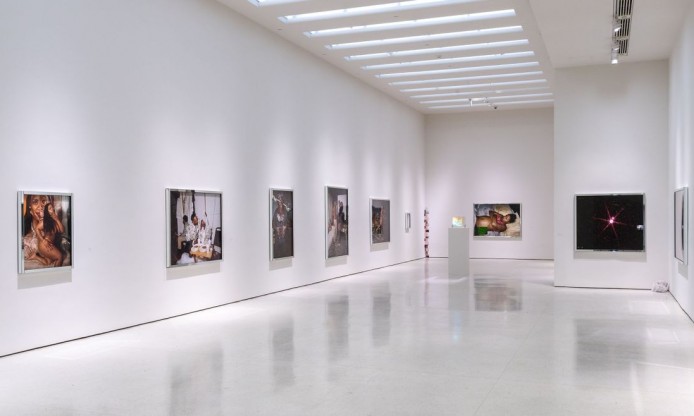image: Installation view, The Hugo Boss Prize 2020: Deana Lawson, Centropy, Solomon R. Guggenheim Museum, New York, May 7–October 11, 2021. © Deana Lawson. Photo: David Heald. from the Guggenheim Museum’s website.
A solo exhibition of Deana Lawson’s is on display at the Guggenheim Museum in Manhattan until October 11, 2021. The Hugo Boss Prize 2020: Deana Lawson, Centropy is organized by Katherine Brinson, Daskalopoulos Curator, Contemporary Art, and Ashley James, Associate Curator, Contemporary Art. The Hugo Boss Prize and the exhibition are made possible by HUGO BOSS.
Deana Lawson’s large-format photographs channel vernacular, art-historical, and documentary traditions within the medium, in compositions that valorize Black diasporic culture.
“I think about that sort of miracle of light,” says Lawson. “I think about the idea that we are all light having a human experience. When I make a picture, it is about being in communion or trying to access an unseen truth.”
In this exhibition, large-scale photographs, some of which are embedded with holograms, are arrayed in a dense constellation that surrounds a spectral rendering of a torus—a three-dimensional shape formed by a circle rotated around a central axis. As such, the installation draws on the thermodynamic concept of centropy, a term that describes how the electrification of matter leads to regeneration and harmonious order. The same impulse of renewal through creative energy is central to Lawson’s vision, in which her subjects are figured as ineffably splendid, occupying a world that they command absolutely.
More info: https://www.guggenheim.org/exhibition/the-hugo-boss-prize-2020-deana-lawson
Deana Lawson (b. 1979, Rochester, NY) creates images that are rooted in a moment from the tangible world, but ultimately exist in the shimmering in-between space of dreams, memories, and spiritual communion, where the everyday is transfigured into the uncanny and the magnificent. Her photographs and films result from collaborations with strangers whom the artist encounters by chance or deliberately seeks out. These individuals are often depicted within richly textured domestic settings in which the details of décor, lighting, and pose are precisely choreographed. In this way, Lawson draws on the legacies of historical portraiture, documentary photography, and the family album, but transcends these traditions, constructing scenes that merge lived experience with imagined narratives.
The aesthetics and intergenerational connectivity of the Black diaspora guide Lawson’s choice of subject matter. Each of her works takes its place in an overarching project, cohering into what she terms “an ever-expanding mythological extended family.” Close examination of her compositions reveals the presence of portals, adornments, and devotional objects that evoke the proximity of an unseen realm. This sense of the celestial is heightened by images of sublime natural phenomena such as galaxies and waterfalls, and in instances where the radiance of an individual seems to burn through the surface of the work itself. Lawson’s works also demonstrate a special attention to the element of light, as both key to the process by which photographs are produced, and a manifestation of the divinity that suffuses her sitters. Recently, Lawson has begun to set her works in mirrored frames that reflect light outward and materialize an exchange between her subjects and the viewer; in her words, they function as “a reflective lining between worlds, that which is ‘seen’ in the photograph, and that which ‘sees.’”


